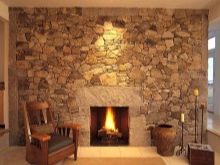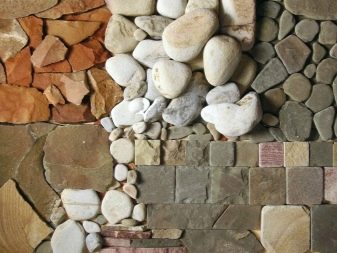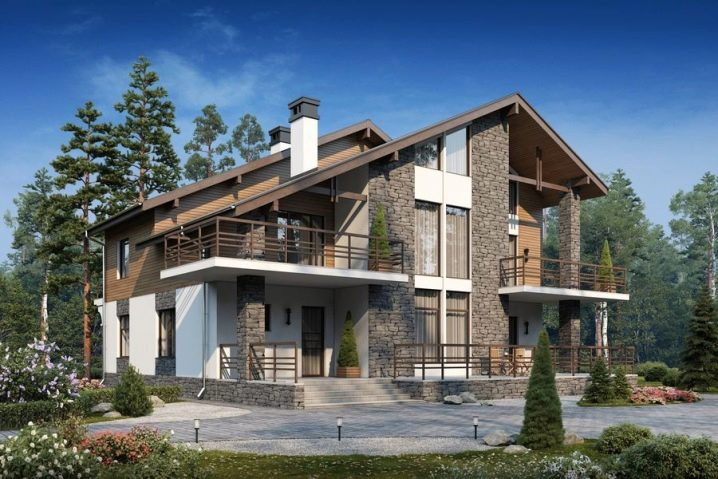Using facing stone for wall decoration

Natural stone can be suitable for fashionable interior and exterior design of the house, if you want to revet the walls with it, you can choose the most diverse options for colors and textures. In addition, such a stylish decoration of the living space can be done even with your own hands. In this article, you will learn how to successfully choose a natural stone and make a beautiful cladding.



Peculiarities
Facing stone is a traditional coating for the facades of houses, but it is often used in the interior as well. It is a beautiful natural material that effectively accentuates almost any design. Nevertheless, to use a stone, you need to study a number of features of such a coating.
First of all, you need to carefully study GOST before planning the laying of natural facing material.: it is very heavy, so this finish should not be taken lightly. It may be necessary to strengthen the foundation of the house or additional reinforcement of the walls. Often, the necessary reinforcement is difficult to implement if the house has already been built, this makes some people abandon cladding with natural stone in favor of lighter options: plastic or wood.


Natural stone slabs can have very different shapes and sizes: in production, the stone is sawn on special machines that allow you to create even and flat slabs for easy installation.
Depending on the design solution, you can choose options of a certain shape and size, or combine different stones to achieve the effect of deliberate negligence. Moreover, the thinner the plates of natural stone, the less the weight of the structure will be.



You should also pay attention to the color of the stone slab: natural material pleases with a wide variety of pleasant natural shades. You can find gray, black, terracotta, beige, pink, or whitish options. All this can be interestingly combined with each other, become a self-sufficient part of the interior or exterior design of your home. Some stones on the cut have an unusual pattern resulting from the mixture and layering of rocks - these options will look especially unusual, but they will be more expensive to work with.
Finally, it is important to pay attention to the features of the texture. Natural stone can be porous, rough, have various inclusions or be homogeneous.
Some slabs for cladding are ground to a glossy shine of the stone, however, options with a perfectly smooth texture are more expensive and do not always look organic, especially when finishing the facade.



Advantages and disadvantages
Today, many synthetic options for finishing materials have been created, which are distinguished by a beautiful appearance, low cost and ease of installation. However, many people still choose natural stone for decorating their living space.
It looks beautiful and is completely environmentally friendly, with such a cladding you can feel closer to nature.
At the same time, the facing stone has a number of both advantages and disadvantages that must be taken into account when choosing.


Since stone remains a popular product for finishing work, despite the high price and complexity of work, it's worth starting with the benefits of this natural material.
- First of all, natural stone is very durable. If wood or plastic finishes require restoration and then replacement after a few years, the masonry will remain in its original form for decades.
- Natural natural stone, unlike synthetic acrylic casting, is resistant to thermal, atmospheric and mechanical influences. You can successfully decorate with this material not only the interior walls of rooms in your house, but also the exterior.
- Frost resistance is a separate quality of natural material, especially relevant for most regions of Russia and the CIS countries.
- The environmental friendliness of the material also matters. Often in a country house you want to use the most natural materials to create a special atmosphere and a sense of unity with the outside world. The stone fits perfectly into this concept.



- Natural stone is fireproof. If suddenly a fire occurs on your site near the house, the house, trimmed with stone, will be protected from fire.
- The natural material is heat resistant. Even if the summer is hot in your area, you may be able to do without an air conditioner: unlike synthetic materials, which easily conduct heat, natural stone will allow you to maintain an optimal pleasant temperature inside the house.
- Stone slabs are waterproof, which can also be a useful quality for both exterior and interior decoration.
- A wide variety of textures, colors and textures will allow you to choose the perfect option for any design project. In addition, you can combine two or three types of stone for an even more unusual decor.



At the same time, the obvious disadvantages of this material should be noted.
- The large weight of natural stone creates a lot of difficulties during its transportation, planning of masonry and direct installation.
- Preliminary calculations must be made to ensure that the foundation and walls will support the weight of the masonry.
- Installation will be laborious for a combination of reasons: this is the large weight of the stone slabs, and the need to lay out small fragments one by one, and the difficulties in cutting the stone when you need to carefully arrange the joints. For these reasons, self-installation causes a number of difficulties, and the work of professionals is quite expensive.
- The stone itself also has a high cost, incomparable with wood or synthetic finishing materials.


Varieties
Wall cladding masonry can have a different appearance and slightly different properties. Before planning the decoration of external or internal walls, the most important thing is to decide what kind of material you want to use.
Consider the following options.
- Sandstone - This is a fairly common stone for decorating the facade of a house, but sometimes it is also successfully used for interior work. Sandstone is a sedimentary rock with a high quartz content. It is rough in texture and torn on chips, and the color scheme is limited to a gray-beige palette, nevertheless, it is a very durable and inexpensive stone, and a discreet color will allow the house to merge with the landscape.


- Limestone Is another inexpensive and common stone. Most often, it has whitish and yellowish shades, although, depending on the impurities, you can find interesting variants of limestone, it can even be black. This option has a porous structure and low density, however, among the advantages it is worth noting the minimum weight of such a stone. One of the popular varieties of limestone is shell rock: usually it is a white or gray crushed stone, in which fragments of mollusk shells are noticeable. Such an unusual solution can look interesting both on the facade and in the interior.


- Dolomite - a stylish, interesting stone that can have a wide color palette: from whitish and gray shades to yellow, beige, pink or terracotta tones. The stone is porous, dense and rough, or marble-like. Nevertheless, all these variants of dolomite are quite close both in their industrial characteristics and in visual properties. Facing with such a stone often resembles a ceramic surface: it is a more or less smooth texture with barely noticeable overflows of color. A rubble stone can look stylish - these are fragments of different sizes with uneven edges.


- Travertine, which is also called tuff, is an intermediate variant between limestone and marble. The stone is light enough, but dense, which allows it to be used in the form of very thin slabs. The most commonly sold Ural travertine, it is predominantly black with beautiful whitish veins, but other interesting options for the color palette are also possible. The stone is easily polished to a perfectly glossy surface and is a cheaper analogue of marble. This option is great for wall decoration both outside and inside the house.


- Caucasian slate widely used for cladding facades of private houses. Most often it is matte, which is an indicator of a high silicon content. However, there are also more rare options that will have a smooth surface and shine. As for the color palette, for slate it is limited to a dark tonal range. Usually these are black or dark gray stones, occasionally dark brown and terracotta variants are possible.


- Granite Is another popular stone that is used in plates of various shapes and sizes, mainly for the external cladding of buildings. An unusual gray-pink color with veins and splashes makes this stone an extremely interesting material for exterior design. For all its originality, the gray stone will not stand out too much on the site; it can be perfectly combined with other materials in the facade decoration.

- Marble - This is a noble stone, which is also often used both for facing the facade of a house and for interior decoration. The material is quite expensive, it is not easy to work with it, but as a result you will get a flawless shiny surface, and the beauty will last for many years. Most often, white, pink or gray marble is used, but its color range is very diverse, it all depends on the impurities that make up its composition.


Today there is also a wide variety of options for artificial stone, it is much more practical for finishing, as it has less weight and thinner slabs. In addition, the color scale and texture of such a stone can be almost any, and the price will not be too high.
Artificial stone will help you easily and budget to bring to life any design idea. However, the material will not be as heat-consuming and durable as natural options.
Application
Natural stone slabs are very often and successfully used both in facade decoration and in interior design. At the same time, stone masonry can look actual in a variety of styles.
If you yourself decided to think over a design project for the exterior or interior of the house, you should decide on the choice of stone.


For outdoor work
It is for the decoration of the facade that masonry is used most often, it allows you to beautifully decorate a concrete wall. For a wooden house, laying stone will not work: the walls are not strong enough. However, you can decorate a concrete house with both wood and natural stone.
Consider the following most fashionable and relevant options.
- If you have planned a house in Russian style, Sandstone or shell rock will suit you: light gray and beige options will create a beautiful facade with a discreet design.If you wish, you can complement the decoration with carved elements of dark or light wood, as well as decorate individual parts with bright ceramic tiles. If you want a more eye-catching façade overall, consider the red-brown artificial material.


- For home in classical or neoclassical style it is worth considering marble. It is best to choose a natural option, however, if the budget does not allow, you can also consider a cast analogue of marble, which outwardly does not differ too much from the real one. This style is mainly characterized by a light finish. Consider a pure white shade or interesting patterns with splashes and colored stains, these details can make your home special.


- For home in scandinavian style dark gray shades of stone are perfect, both natural and artificial options can be considered. Irregularly shaped stone slabs will look best, this will create the effect of deliberate negligence and antiquity. However, if you prefer a more modern aesthetic, you can find a stone in the shape of narrow bricks that will also look good.

In the interior
You can also use masonry to decorate the walls of rooms inside your home. The stone goes well with any wallpaper, wood clapboard or ordinary wall painting. Brick or stone is rarely used for interior decoration of the entire interior; such masonry can look too flashy. OUsually stone is just one of the accents in the interior.
- Very often all kinds of stones are used country style... This design solution is especially typical for houses with wooden interior decoration. In such an interior, beige and terracotta stone can look great. If you want to play on the contrast of shades, you can choose gray and whitish tones for wood: this solution will additionally highlight the masonry. For a living room, dining room, loggia or hallway, a combination of wood and stone is perfect.


- Modern style it is customary to combine unexpected contrasting tones. For example, a combination of black and white marble can look great in decoration. For a small room, it is better to make a light base with small dark decorative elements, and if the space is large, then you can decorate it with a predominantly dark tone or combine colors in equal proportions.


- If you want to decorate the interior art nouveauDolomite with its unusual texture and wide range of colors will suit you. If the rest of the decoration of the house is rather restrained, you can combine different color shades of the stone and even lay out a mosaic of them. At the same time, the stone will be perfectly combined with any textiles, wallpaper, lacquered wood, metal and ceramics.

Useful Tips
The choice of stone for decoration is very important. If you are thinking of such a design for the exterior or interior of your home, but do not know where to start, take note of the advice of designers.
- Before purchasing the desired stone and carrying out the installation, it is very important to perform calculations: for this you will need detailed characteristics of the foundation, the parameters of the walls, their thickness and density. All this data must be taken from the developer if you have planned stone finishing. If you are not sure whether the walls will withstand your finish, you can order a calculation from professionals.
- Putting natural material with your own hands is worth it only if you have initial knowledge and skills in such a matter. If not, it is better to turn to professionals or choose an artificial stone for self-assembly: it is much easier to work with it, some options can simply be glued to a special solution.


- When working with natural stone, finishing the corners is especially difficult: you need to accurately calculate the amount of stone so that it is enough for them.If you are doing the finishing yourself, take care of cutting the stones to the correct size.
- When decorating the interior, special attention should be paid to the joints with the floor. Regardless of what kind of covering you have - laminate, linoleum or parquet, it is best to place the plinth around the perimeter. If you think that it does not fit into the design, it is important to arrange the joints very carefully, properly sawing the stone and glue it carefully, applying the cladding over the floor covering at the joint so that there are no gaps.


Best options
There are many options for decorating the facade and interior using stone. If you can't decide on the design, consider ready-made ideas. Perhaps successful design projects will inspire you on your own.
- When decorating the facade of a house, it is by no means necessary to cover the entire house with stone. The masonry can also look interesting with other decor, for example, conventional staining. Please note that the stone should stand out against the general background, but not be overly contrasting. Usually, masonry is chosen darker than the main color of the house.
- Natural material can allow you to organically fit your home into the surrounding landscape. To emphasize the closeness to nature and harmony with it, try to decorate with stone not only the walls of the house, but also the elements nearby - stairs, paths, fountains or flower beds. This will help you combine the entire site into a single ensemble.


- In the interior, masonry always looks unusual, but in order to highlight it, it is not necessary to choose a bright stone color. Quite discreet brown, beige and gray options can be accentuated with the right lighting. Nowadays, LED wall lamps are in vogue, they will help not only create a pleasant soft light in the room, but also additionally highlight the unusual texture of the masonry.
- If you decide to decorate with stone not just one wall in the room, but a wider area, you should not choose a monochromatic material, such cladding often looks very boring. At the same time, it is also better to avoid contrasting options so that the interior is not colorful. The ideal solution is to take several colors that are close in color, but different in tone. For this, for example, beige colors are perfect: you can combine cream, ocher and brown shades.


See the next video for more details.













The comment was sent successfully.